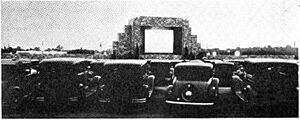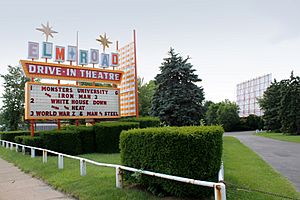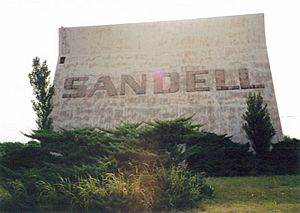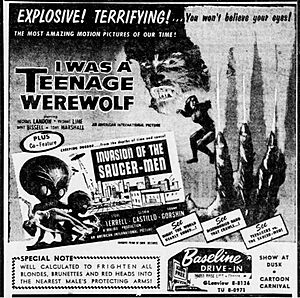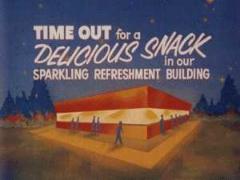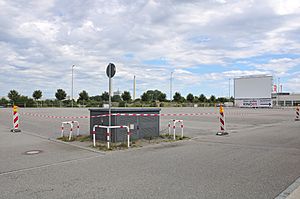Drive-in theater facts for kids
A drive-in theater is a special kind of movie theater. It has a huge outdoor screen, a place for the projector, a snack bar, and a big parking area. People watch movies from inside their cars, which gives them privacy and comfort. Some drive-ins even have small playgrounds for kids or picnic tables.
The screen can be a simple white wall or a strong metal structure. In the beginning, movie sound came from speakers near the screen. Later, small speakers hung on car windows. Now, the sound is usually sent to car radios. This lets people hear the movie in stereo, which sounds much better. It also stops drivers from accidentally driving off with the speaker still attached!
History of Drive-Ins
Early Days: Before the 1940s
One of the very first places to show movies to people in their cars was the Theatre de Guadalupe in Las Cruces, New Mexico, in 1915. It had space for over 40 cars. The first movie shown there was Bags of Gold.
In 1921, Claude V. Caver opened a drive-in in Comanche, Texas. People parked their cars close together to watch silent films. Outdoor movies became popular in the 1920s, but it was tricky to set up drive-ins back then.
The idea for the modern drive-in theater was patented by Richard M. Hollingshead, Jr., in Camden, New Jersey. In 1932, he tested his idea in his own driveway. He put a screen on trees, used a projector on his car hood, and placed a radio behind the screen for sound. He even used blocks under cars to figure out the best way for everyone to see the screen. He got his patent on May 16, 1933.
Hollingshead's first drive-in opened in Pennsauken Township, New Jersey, on June 6, 1933. It had space for 400 cars and a large screen. He advertised it by saying, "The whole family is welcome, regardless of how noisy the children are." The first movie was Wives Beware.
Other drive-ins soon opened across the United States. Early drive-ins had problems with sound because speakers were only at the screen. In 1941, a company called RCA introduced speakers that you could hang on your car window. These had individual volume controls and solved the sound problems. Before World War II, many drive-ins were run by Philip Smith, who made them family-friendly by letting children in for free and building playgrounds.
Golden Age: 1940s to 1960s
After 1945, more people owned cars, and families were growing. This led to a huge increase in drive-in theaters. By 1951, there were over 4,000 drive-ins in the United States.
Drive-ins were most popular in the late 1950s and early 1960s. They were often cheaper than indoor cinemas. It cost less to build and run a drive-in, so tickets were more affordable. One big advantage was that parents could bring their babies and young children without worrying about disturbing others. Young people also found drive-ins great for dates.
Drive-ins were known for being family-friendly. They offered things like bottle warmers and diaper vending machines. Some even had miniature golf courses, swimming pools, or motels where you could watch the movie from your bed! During the 1950s, some people called drive-ins "passion pits" because they offered more privacy. The 1978 movie Grease shows a drive-in as a popular place for young couples.
To attract more people, some drive-ins used fun tricks. They had prize drawings, free admission, or even small airplane runways. Some offered helicopter or hot air balloon rides. Others had small petting zoos or monkeys. Sometimes, actors or musical groups would appear before the show. Many drive-ins held Sunday religious services or offered special low prices on certain nights.
One of the biggest drive-in theaters was the Johnny All-Weather Drive-In in Copiague, New York. It covered over 29 acres and could hold 2,500 cars. It had a full restaurant and a trolley system to take people to a playground. The largest in the world was Loew's Open Air in Lynn, Massachusetts, which could hold 5,000 cars.
Decline: 1970s to 1990s
Several things caused drive-ins to become less popular. In the late 1960s, home entertainment improved with color television and cable TV. Then, in the early 1980s, VCRs and video rentals arrived. Families could now watch movies comfortably at home. Also, the energy crisis in the 1970s meant people used their cars less, and daylight saving time made movies start later.
By the late 1970s, many drive-ins started showing older movies or films not meant for families. This was a way to try and make more money as fewer people were coming. However, movie rental fees were going up, and drive-ins struggled to compete with indoor cinemas.
The cost of land also became a big problem. Drive-ins needed large areas, and land prices increased a lot in the late 1970s and early 1980s. Many drive-ins only opened on weekends or during spring and summer. Bad weather also caused low attendance or cancellations. By the late 1980s, fewer than 200 drive-ins were left in the United States and Canada.
Many old drive-in sites were used for other things, like storage or flea markets. Some became shopping centers, industrial parks, or even churches. For example, the South City Drive-In in Philadelphia became the site of the Spectrum arena.
Comeback and New Ideas: Late 1990s to 2000s
By the late 1990s, drive-ins started to become popular again. People felt a sense of "nostalgia" for the old days, and loyal fans kept them going. This led to a small comeback.
Around 2001, "do-it-yourself" drive-ins started appearing. These used modern tools like LCD projectors and small radio transmitters. The first was the Liberation Drive-In in Oakland, California, which used empty parking lots in cities. Soon, "guerrilla drive-in" groups formed. They would organize outdoor movie showings online, meeting at places like bridge pillars or warehouses. They often showed independent or unusual films.
A newer idea is the "boutique" drive-in. These are smaller, usually for 30 to 50 cars. They often have food trucks for snacks. Unlike guerrilla drive-ins, they usually show popular new movies and classic films. They focus on the "vintage" look and feel of old drive-ins.
In 1999, Hull's Drive-In in Lexington, Virginia, was going to close. But a group called Hull's Angels raised money to buy it and run it as a non-profit. It's still the only non-profit drive-in in the United States, showing family-friendly movies.
By 2006, about 500 drive-in theaters were open in the United States. The industry also saw a rebound in Canada and Australia.
Today: Digital Changes and New Life
In the late 2000s, drive-ins faced another decline due to economic problems. Fewer people were using cars, and more were moving out of rural areas. By 2013, only 389 drive-ins were operating in the United States.
In 2010, the Galaxy Drive-In Movie Theater in Ennis, Texas, became the first drive-in to show 3-D films.
A big challenge for drive-ins has been switching from film to digital projection. Digital projectors are very expensive, costing at least $70,000 per screen. Many small drive-ins can't afford this. Digital projectors also need more powerful bulbs for large outdoor screens and require special changes to the projection booth.
Some drive-ins are now using large digital display screens, like Jumbotrons. These don't need a projector booth at all. By October 2019, the number of operating drive-in theaters rose slightly to 305, partly due to new, smaller "boutique" operations.
During the COVID-19 pandemic, drive-in theaters saw a big increase in visitors. Unlike indoor theaters, drive-ins could stay open because people were separated by their cars. They even hosted events like graduations. The Fort Lauderdale Swap Shop, which opened in 1963, is the world's largest drive-in theater and also a huge daily flea market.
The Drive-In Experience Today
Since 2020, there has been new interest in drive-in theaters in North America. During the pandemic, drive-ins made up a large part of movie ticket sales. This new popularity is also growing in other countries.
Many new drive-ins have modern designs. They use electronic screen systems that allow movies to be shown even during the day. This improves the picture quality and makes it more convenient. They also have better snack areas and restrooms. For example, LoCo Drive-In plans to host car shows and community gatherings.
The Drive-In Experience Ottawa opened in 2020 and now has two locations. Besides movies, they host live comedy shows and concerts. They also rent out the space for events like graduations and weddings. They have a big screen, wireless sound for car radios, and a stage for live shows. This community-focused model helps drive-ins stay open for the future. Local businesses can also rent the space for private events or even yoga classes.
This trend is happening in other places too. In Ontario and other Canadian provinces, many drive-ins now offer live concerts and other entertainment, while still focusing on family-friendly movies. Some drive-ins in Nova Scotia and New Brunswick even host religious events and community activities.
Drive-in Theaters Around the World
Australia
Drive-in theaters became popular in Australia in the 1950s and 1960s. The Hoyts Skyline in Melbourne was the first, opening in 1954. Many served American-style food. At their peak in the mid-1960s, there were about 330 drive-ins. As of August 2025, only 12 drive-ins operate regularly, with a few others opening sometimes. The Gepps Cross Drive-In closed in February 2022.
The world's most remote drive-in might be in Coober Pedy, South Australia. It opened in 1965 but closed in 1984 when TV arrived. It reopened in 1996 and has been run by volunteers since 2000. It is still open as of August 2025 and is the last drive-in in South Australia. Because opal miners sometimes carried explosives, the drive-in banned them! In November 2023, strong winds destroyed the screen, but volunteers hope to rebuild it.
Finland
Finland has had a few drive-in theaters. One of the first was at the Keimola Motor Stadium in the late 1960s. More recently, some opened in Kaarina in 2017, and in Turku and Vantaa in 2020.
Germany
Germany's first drive-in theater, the Gravenbruch, opened in April 1960 near Frankfurt. It showed The King and I. At that time, the only other drive-ins in Europe were in Rome, Italy, and Madrid, Spain.
Greece
Greece had outdoor theaters as early as 1919. The first drive-in theater in Greece started being built in 1960 near Athens. It was planned to open in August 1961. Today, viewers can enjoy classic movie snacks or Greek treats like grilled calamari and souvlaki.
Iran
In 2020, Iran showed its first drive-in film, Exodus, during the COVID-19 pandemic. However, the country had a drive-in before 1979.
Italy
Europe's first drive-in theater opened in Rome in 1954.
Philippines
The SM Supermalls shopping mall chain opened the Philippines' first drive-in theater near SM City Pampanga on July 31, 2020. They also opened a temporary one at the SM Mall of Asia concert grounds in September 2020. As of August 2025, there are two SM Supermalls drive-in locations.
Spain
Spain's first drive-in theater opened in Madrid in 1958. It was called Motercine and was located near Barajas Airport.
Sweden
In 2011, the Stockholm International Film Festival held its first drive-in theater event. It was brought back during the COVID-19 pandemic in 2020. Since then, it has become the largest drive-in theater in the Nordic region. It's now an annual five-day event in June, with outdoor screenings on a large LED screen.
See also
 In Spanish: Autocine para niños
In Spanish: Autocine para niños
- Societal effects of cars
- List of drive-in theaters
- Outdoor cinema
- Inflatable movie screen


